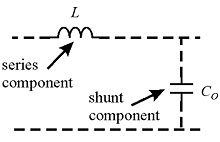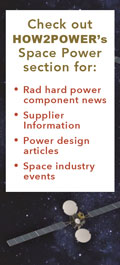 |
|
IN THIS ISSUE:
» The Engineer’s Guide To EMI In DC-DC Converters (Part 12): Predicting The Differential-Mode Conducted Noise Spectrum
» How To Make Sense Of Sense Resistors
» Choosing The Best Operating Mode In An Ultra-Low-IQ Buck Converter
» Focus On Magnetics:
Optimize Inductor Design To Minimize Output-Filter Size
» Spotlight On Safety & Compliance:
The Ever Evolving And Complex World Of Materials Compliance And Declarations
» New Power Products
» Other Top Power News
From the Editor's Desk David G. Morrison
Editor, HOW2POWER TODAY

When APEC was cancelled last month, it likely evoked a mix of emotions. There was disappointment over missing all of the opportunities that a great conference like APEC affords. But there was also relief in that many were worried about the safety of traveling at a time when the COVID-19 pandemic was starting to show signs of trouble in the U.S. It turns out those fears were well founded. In the weeks that have passed, the number of COVID cases in this country has skyrocketed and many lives have been tragically lost even as this pandemic has spread across the globe. It has created hardships and disrupted daily life in ways most of us never imagined. Presently, nearly all aspects of our lives are impacted and while some effects are (hopefully) short term, there’s little doubt this pandemic will produce other, longer lasting changes. Since technology is the cornerstone of society’s response to all types of problems, we can expect that engineers will be called on to address issues stemming from the current crises. In the electronics world, we see immediate examples of this with companies stepping up to redesign ventilators to overcome shortages. But what will be the long-term trends that emerge? Perhaps on a broad scale there will be new engineering and manufacturing requirements as we expand emergency preparedness for pandemics and other disasters. Perhaps funding or resources will be diverted from certain industries or applications to others, as society’s priorities change. As we grapple with the new realities, I’m sure we all have ideas about what will or should change as a result of the pandemic, how technology can be applied, and the roles that engineers can play in making these things happen. Hopefully some positive developments will emerge as “silver linings” from an otherwise troubled time.
|
|

 |
 |

|
HOW2POWER EXCLUSIVE DESIGN ARTICLES 
|
The Engineer’s Guide To EMI In DC-DC Converters (Part 12): Predicting The Differential-Mode Conducted Noise Spectrum
by Timothy Hegarty, Texas Instruments, Phoenix, Ariz.
In general, complying with EMC standards is an increasingly important task for switching power supplies, not because of excessive total spectral energy but more so the concentrated energy in specific narrow bands at the fundamental switching frequency and its harmonics. Custom-designed passive filtering at the input of a dc-dc regulator is the most common approach for mitigating EMI. To this end, part 12 now examines the modeling of differential-mode (DM) noise, including the converter, passive EMI filter and measurement equipment. This article takes into account the modeling of the converter and the measurement equipment, such as the line impedance stabilizing network (LISN) and the EMI test receiver (TR), in order to streamline and better predict the effectiveness of the DM filter design. The converter input current is modeled as a current source and its harmonic content is estimated by Fourier analysis.
Read the article…
|

DM equivalent of a π-stage EMI filter
circuit for a dc-dc regulator. The design
of such filters is challenging, since the
filters are terminated with varying
impedances both at the noise source (the
regulator) and the load (the power lines). |

|

Using the pulse-response method to
measure the parasitic series
inductance of a sense resistor. |
How To Make Sense Of Sense Resistors
by Dennis Feucht, Innovatia Laboratories, Cayo, Belize
This article is a mini-tutorial on fundamental concepts for power-circuit design involving sense resistors. This article discusses a variety of problems that must be understood to obtain accurate measurements with sense resistors including temperature effects, properties of resistor materials, make-versus-buy options, and Kelvin sensing. The explanations on those topics set the stage for the more-detailed discussions that follow on how to measure resistor parasitics. Two methods for measuring the parasitic series inductance of sensor resistors on the bench—frequency sweep and pulse-response methods—are explained to enable designers to properly evaluate and characterize sense resistors for use in power supply circuits. These methods are highly accessible in that they employ an oscilloscope, sine and square-wave generators, and basic probing accessories.
Read the article…
|

Choosing The Best Operating Mode In An Ultra-Low-IQ Buck Converter
by Chris Glaser, Texas Instruments, Dallas, Texas
Through ultra-low-power techniques and ultra-low quiescent current, a stepdown converter extends the battery run time for many portable devices, such as earbuds, sensors and smart meters. But to be useful, a buck converter must still meet the performance needs of the system, such as responding to load transients from the radio or generating low-enough noise for a data converter. To do this, the TPS62840 ultra-low-power buck converter has numerous operating modes. This article describes each of its five operating modes: shutdown, power-save, forced pulse-width modulation, 100% and stop mode. Furthermore, the article explains their impact on IQ, their system benefits, and how each mode supplies the required performance while drawing appropriately low currents.
Read the article…
|

The buck converter enters and
exits stop mode almost
instantaneously, providing a
noise-free window during which
the system can make measurements. |


FOCUS ON MAGNETICS 
Sponsored by Payton Planar Magnetics
A monthly column presenting information on power magnetics design, products, or related technology |

Optimize Inductor Design To Minimize Output-Filter Size
by Dennis Feucht, Innovatia Laboratories, Cayo, Belize
In the converter PWM-switch CP (buck) and CA (boost) configurations, the PWM-switch inductor, L, is in series with the input and output ports. The output capacitor, Co, is in parallel with the output port. Actual L and Co components have parasitic series resistance which causes power loss. Both the inductor and the output storage capacitor are subject to either design or component selection by which the loss in each can be determined. It’s common that they are the largest components in a converter. Their combined component size can be minimized by not allowing either component to become much larger than the other. In this article, equations are derived to enable the inductor and capacitor to be similarly sized in order to minimize overall filter size (volume).
Read the full article…
|

We approach the problem of
minimizing overall filter size from
a thermal viewpoint and set out
to equalize the inductor and
capacitor power losses. |

 |
 |

SPOTLIGHT ON SAFETY & COMPLIANCE 
Sponsored by Power Integrations
A monthly column discussing standards and regulatory requirements affecting power electronics |

The Ever Evolving And Complex World Of Materials Compliance And Declarations
by Kevin Parmenter, Chair, and James Spangler, Co-chair, PSMA Safety and Compliance Committee
Compliance concerns are not just about staying on the right side of social and environmental regulations. These issues impact the long-term viability of your organization and its ability to sell products. The two most adhered-to regulatory standards are EU REACH and EU RoHS. However, attention to the health of citizens and the environment has led to the implementation of guidance and regulation around the world. There are guidelines and regulations that apply on a regional level, but also those that are country specific and, within the U.S., even state-level regulations. These rules may apply differently in various countries of manufacture and there may be differences with respect to the end markets. In this article, we will provide a brief overview of the major materials compliance directives and regulations that are enforced across the globe. Then, we will provide further background on conflict minerals and explain the regulatory requirements imposed on the use of such materials in the U.S.
Read the full article…
|

 |
 |

 — POWER PRODUCTS IN 3 IMAGES OR LESS — POWER PRODUCTS IN 3 IMAGES OR LESS 
|

What We Missed At APEC: Silicon Carbide Marches On And Other Power Product News
by David G. Morrison, Editor, How2Power.com
In the wake of APEC 2020’s cancellation, would-be exhibitors created web pages and virtual exhibits, and scheduled press briefings to share their APEC-related news. This report presents numerous highlights from those web efforts and briefings, bringing you some of the notable power component news, demos, customer examples and product roadmaps you might have seen at APEC 2020 in New Orleans had it been held. As at past APEC exhibitions, wide-bandgap semiconductor news featured prominently. See the full story… |


 |

|


Infineon Technologies’ 650-V
CoolSiC MOSFETs. |
650-V SiC MOSFETs Offer High Reliability And Performance
 Photo: The new 650-V CoolSiC MOSFETs are well suited for hard- and resonant-switching topologies such as LLC and ZVS, and can be driven like an IGBT or CoolMOS MOSFET, using standard drivers. According to Infineon, these robust devices offer superior gate-oxide reliability enabled by state-of-the-art trench design, best-in-class switching and conduction losses, highest transconductance level (gain), a 4-V threshold voltage and short-circuit robustness. Photo: The new 650-V CoolSiC MOSFETs are well suited for hard- and resonant-switching topologies such as LLC and ZVS, and can be driven like an IGBT or CoolMOS MOSFET, using standard drivers. According to Infineon, these robust devices offer superior gate-oxide reliability enabled by state-of-the-art trench design, best-in-class switching and conduction losses, highest transconductance level (gain), a 4-V threshold voltage and short-circuit robustness.
See the full story…
|

Renesas Electronics’ power
management IC reference designs.
|
PMIC Reference Designs For Xilinx FPGAs And SoCs Speed Time To Market
 Photo: Based on the multi-phase ISL91211AIK and ISL91211BIK PMICs, three PMIC reference designs have been developed for powering the supply rails of Xilinx Artix-7 FPGAs, Spartan-7 FPGAs, and Zynq-7000 SoCs. These designs provide user-friendly turnkey solutions that enable a single design to support different Xilinx speed grades and DDR memory types, and speed the development of power supplies for a variety of industrial and computing applications. Photo: Based on the multi-phase ISL91211AIK and ISL91211BIK PMICs, three PMIC reference designs have been developed for powering the supply rails of Xilinx Artix-7 FPGAs, Spartan-7 FPGAs, and Zynq-7000 SoCs. These designs provide user-friendly turnkey solutions that enable a single design to support different Xilinx speed grades and DDR memory types, and speed the development of power supplies for a variety of industrial and computing applications.
See the full story…
|

 |

|

Performance Motion Devices’ Juno
Velocity Control ICs.
|
Low-Cost ICs Provide Advanced Velocity Control Of Servo Motors
 Diagram: The Velocity Control ICs are said to offer a price-to-performance breakthrough with features such as PI velocity loop control, programmable velocity estimation, dual biquad filtering, shunt regulation, deadband filtering, field oriented control, and more, yet are priced at just $23 in quantity. Diagram: The Velocity Control ICs are said to offer a price-to-performance breakthrough with features such as PI velocity loop control, programmable velocity estimation, dual biquad filtering, shunt regulation, deadband filtering, field oriented control, and more, yet are priced at just $23 in quantity.
See the full story…
|


|










|
OTHER TOP POWER NEWS
|
|
 EnerHarv 2020, the international Energy Harvesting Workshop, originally scheduled to be held June 16-18 in Raleigh, N.C., has been cancelled due to the COVID-19 pandemic. For more details, see the workshop website. EnerHarv 2020, the international Energy Harvesting Workshop, originally scheduled to be held June 16-18 in Raleigh, N.C., has been cancelled due to the COVID-19 pandemic. For more details, see the workshop website.
 Portable Electric has shifted production of its battery products to serve the healthcare and emergency services industry, aiding the Pacific Northwest relief efforts amid the COVID-19 pandemic. Portable Electric has shifted production of its battery products to serve the healthcare and emergency services industry, aiding the Pacific Northwest relief efforts amid the COVID-19 pandemic.



 Pre-Switch, a Silicon Valley start-up that has developed an artificial intelligence dc-ac, ac-dc soft-switching controller delivering efficiency and performance benefits, has appointed Foxy Power from Berlin, Germany as its strategic partner for business development and sales. Pre-Switch, a Silicon Valley start-up that has developed an artificial intelligence dc-ac, ac-dc soft-switching controller delivering efficiency and performance benefits, has appointed Foxy Power from Berlin, Germany as its strategic partner for business development and sales.
 In response to the COVID-19 pandemic, EMA Design Automation is offering free access to work-from-home licenses, including OrCAD PCB Designer Professional, PSpice, Ultra Librarian for OrCAD, and access to the entire online learning catalog. In response to the COVID-19 pandemic, EMA Design Automation is offering free access to work-from-home licenses, including OrCAD PCB Designer Professional, PSpice, Ultra Librarian for OrCAD, and access to the entire online learning catalog.


 What’s described as the world’s most powerful 1500-Vdc string inverter, Sungrow’s SG250HX 250-kW PV inverter features Infineon Technologies’ customized EasyPACK 3B power modules, which in turn contain the latest TRENCHSTOP and CoolSiC chip technologies. What’s described as the world’s most powerful 1500-Vdc string inverter, Sungrow’s SG250HX 250-kW PV inverter features Infineon Technologies’ customized EasyPACK 3B power modules, which in turn contain the latest TRENCHSTOP and CoolSiC chip technologies.
 The 2020 CPES Annual Power Electronics Conference and the PEC (Power and Energy Center) Conference, both at Virginia Tech, have been rescheduled for August 30-September 2, 2020. The 2020 CPES Annual Power Electronics Conference and the PEC (Power and Energy Center) Conference, both at Virginia Tech, have been rescheduled for August 30-September 2, 2020.
|

ABOUT THIS NEWSLETTER: Thank you for reading HOW2POWER TODAY.
How2Power sends no more than one e-mail per month to registered users. Continuing your subscription ensures you'll receive future newsletters. Manage Your Subscription
©2020 All rights reserved. www.how2power.com
|
|